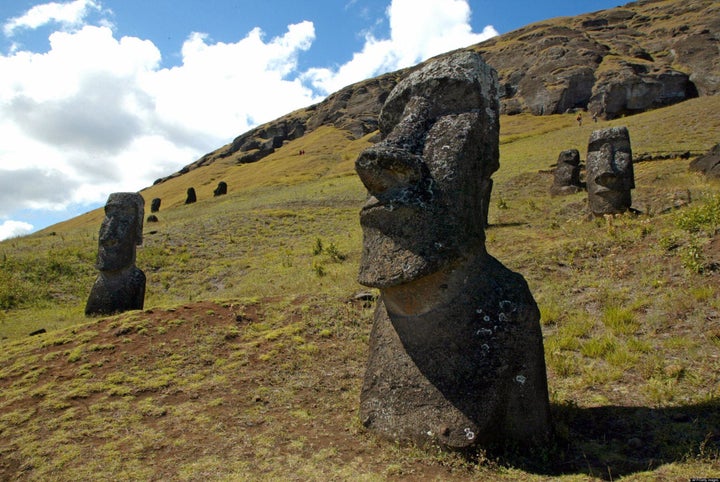
For years, Rapa Nui (Easter Island) in the South Pacific with its great statues, the enigmatic moai, has been the poster child for humanly caused ecological catastrophe.
When Europeans stumbled across the island in 1722, an estimated 3,000 seemingly impoverished people and numerous moai dwelt on the islands. Almost immediately, the mythmaking began, of a once prosperous, statue-building, but isolated society that dissolved in the face of deforestation, food shortages, and endemic conflict.
The island has acquired renewed notoriety in recent years, notably at the hands of Jared Diamond, as a textbook example of what happens when humans unleash their destructive passions on a pristine environment. Thousands of majestic Easter Island palm trees covered Rapa Nui only to vanish in the face of strangers in canoes.
Now it turns out that this scenario may be entirely wrong. Two respected archaeologists, Terry Hunt and Carl Lipo, with a broad experience of Polynesian islands, have come up with a very different, rigorously tested scenario. Ecological collapse simply does not stand up ion the face of 21st-century multidisciplinary science.
Settling Rapa Nui
For generations, scientists assumed that Polynesians first settled Rapa Nui during the first millennium A.D., just as they did other islands in remote Oceania. Hunt and Lipo caused a seismic shift in island history when they uncovered the original land surface where Easter Island palms grew densely at a stratified archaeological site by Anakena Beach on the northeastern shore. Here the earliest human occupation dated to about A.D. 1200, centuries later than previously accepted dates for first settlement. Not only that, but newly completed fossil pollen studies confirmed the first human interference with island vegetation to the same time frame.
Precision radiocarbon dating based on hundreds of dates from Polynesian islands has rewritten the chronology of Pacific voyaging. We now know that canoes sailed eastward from Samoa around A.D. 1100. Then, within a century or so from the islands of Tahiti, the entire colonization of the remoter Polynesian islands, including Hawai'i, New Zealand, Marquesas, and Rapa Nui unfolded within a mere century. People seem to have reached Rapa Nui before Hawai'i. They brought fast-breeding Pacific rats with them, which flourish alongside people. These were the villains, who gradually deforested much of the island, argue the two archaeologists. Almost no trees survived at European contact five centuries later.
Surviving an Impoverished Island
How, then, did the islanders survive, when they lacked two Polynesian staples -- dogs and pigs? Satellite and ground surveys provided a satisfying answer. It turns out that the islanders used rock-walled circles to protect crops like bananas and taro in waste-enriched soil from dehydration and the wind. Ground surveys located at least 2550 circles, some still in use, that once enclosed over 10% of the island's surface. The islanders also practiced stone gardening over almost half the island, placing rocks around plants to protect them and retain moisture, a familiar method in many arid parts of the world. As the forest declined, the authors tell us, so the islanders transformed the now open terrain into an endless series of gardens. They were able to survive reasonably comfortably and sustainably.
What about the Moai?
Why then, carve and erect moai? Hunt and Lipo mapped paths that radiate outward from the extensive quarry where the statues originated. They believe that carvers from different groups worked alongside one another, each hauling their statues along often poorly defined, even idiosyncratic paths. Contrary to much earlier theorizing, they also argue that statue building and transport was not in the hands of powerful chiefs, nor did it consume much valuable timber. Each statue was "engineered to move," standing upright. It "walked" and was designed to do so with the help of small numbers of people. Think of moving your fridge and you get the idea.
A Hollywood complete with warriors and chiefs and all kinds of publications feature internecine warfare and fights to the death. Good movie fare, but certainly not historical reality. Hunt and Lipo point out that the island was too small and the terrain too rugged for large-scale fighting. Nor, apparently, were there all-powerful chiefs living in great villages. But, if there were no powerful chiefs and people lived in dispersed settlements, why did the islanders expend so much effort on huge statues? They argue that cooperation between independent groups was the most effective strategy for survival in a place where people maintained a delicate balance between food supplies and population size. This cooperation may have been reflected in the construction and erection of moai, as did the rituals associated with them that are lost to us.
Far from collapsing, Rapa Nui society actually flourished until confronted by European visitors, who brought epidemic disease and other familiar evils with them. If there was an Armageddon on this remote island, it was not of the Polynesians' making.
Hunt and Lipo freely admit that much detailed inquiry lies ahead to fill out the details and to confirm their hypotheses. In the meantime, they've summarized their closely argued theories in a nicely written book, The Statues That Walked.
Only very rarely do two scholars revolutionize a chapter of history. But this important research, even if modified by future inquiry, offers a compelling alternative to the ecological Armageddon of so much popular literature. And it provides us with ample reason to respect the cultural heritage of Rapa Nui's indigenous inhabitants.
Never believe what the movies tell you about environmental history!